
Parkinsonia aculeata is a species of perennial flowering tree in the pea family, Fabaceae. Common names include palo verde, Mexican palo verde, Parkinsonia, Jerusalem thorn, jelly bean tree, palo de rayo, and retama.

Lathyrus japonicus is a legume native to temperate coastal areas of Asia, Europe, and North and South America.

Acacia inaequilatera, commonly known as kanji bush, baderi, camel bush, fire wattle, kanyji bush or ranji bush is a tree in the family Mimosaceae. Endemic to Australia, it is widely distributed in the semi-arid Triodia country eastwards from Karratha, Western Australia into the Northern Territory.
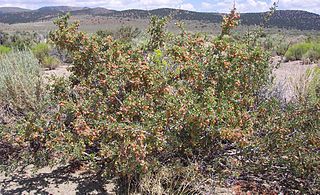
Prunus andersonii is a species of shrub in the rose family, part of the same genus as the peach, cherry, and almond. Its common names include desert peach and desert almond. It is native to eastern California and western Nevada, where it grows in forests and scrub in desert and mountains. It was named after Charles Lewis Anderson by Asa Gray.

Prunus fasciculata, also known as wild almond, desert almond, or desert peach is a spiny and woody shrub producing wild almonds, native to the deserts of Arizona, California, Baja California, Nevada and Utah.
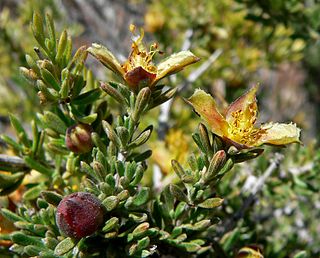
Coleogyne ramosissima or blackbrush, is a low lying, dark grayish-green, aromatic, spiny, perennial, soft wooded shrub, native to the deserts of the southwestern United States. It is called blackbrush because the gray branches darken when wet by rains. It is in the rose family (Rosaceae), and is the only species in the monotypic genus Coleogyne.

Grayia is a genus of plants in the subfamily Chenopodioideae of the family Amaranthaceae. Common names are siltbush and hopsage. The four shrubby species occur in arid and semiarid regions of western North America:
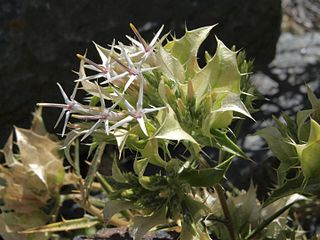
Hecastocleis is a genus of low thorny shrubs with stiff branches, assigned to the daisy family. At the tip of each of the branches, inflorescences are subtended by oval, thorny, whitish to greenish bracts that enclose several flower heads which each contain only one pinkish bud, opening into a white corolla. It contains but one species, Hecastocleis shockleyi, the only representative of the tribe Hecastocleideae, and of the subfamily Hecastocleidoideae. Its vernacular name is prickleleaf. It is confined to the southwestern United States.
Ehpedra alata is a species of Ephedra. These plants are perennial and xerophytic gymnosperm shrubs.

Euphorbia balsamifera is a flowering plant in the spurge family Euphorbiaceae. It is distributed from Arabian Peninsula to Sahara and Canary Islands. It is the vegetable symbol of the island of Lanzarote.

Balanites aegyptiaca is a species of tree, classified as a member of either the Zygophyllaceae or the Balanitaceae. This tree is native to much of Africa and parts of the Middle East.

Rhinotropis acanthoclada, synonym Polygala acanthoclada, is a species of flowering plant in the milkwort family known by the common names desert polygala and thorn milkwort. It is native to the desert woodlands of the southwestern United States from Utah to the Mojave Desert. It is a small, bushy shrub spreading or growing erect and approaching one meter in maximum height. It is hairy in texture, the youngest twigs hairiest with a feltlike coat of short, whitish fibers. The lance-shaped or oval leaves are up to 2.5 centimeters long. Some of the twigs narrow to spines at the tips, especially in the inflorescences. The flowers are solitary or in clusters of up to 15. Each flower has five sepals, the lateral two white in color and spreading out like wings. The middle petal is keeled, with a flat tip protruding. The fruit is a capsule about half a centimeter long.

Senna armata is a species of flowering plant in the legume family known by the common names spiny senna and desert senna. It is native to the desert regions around the intersection of Nevada, Arizona, eastern California and northern Baja California, where it grows in sandy and rocky habitat, such as arroyos. It is a shrub growing up to a meter tall, its grooved, branching stems often narrowing to thorns at their tips. The spiny branches are coated in tubular hairs which help protect it from hot desert air. The spine-tipped leaves are each made up of two to four pairs of small leaflets. The leaves are ephemeral, dropping soon after emerging, leaving the shrub naked most of the time. Flowers occur singly or in small clusters in leaf axils. They are fragrant and showy, with five petals in shades of yellow to salmon pink, each measuring roughly a centimeter long. The fruit is a legume pod up to 4 centimeters long.
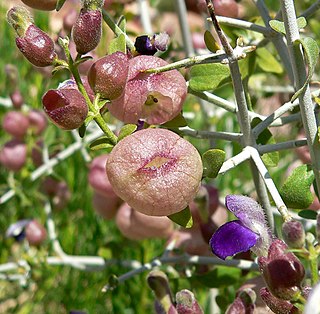
Scutellaria mexicana, commonly known by variants on bladder sage or paperbag bush, is a shrub of the mint family Lamiaceae distinctive for its calyx lobes that develop into small bag- or bladder-like shells around the fruits.
Peniocereus striatus is a species of cactus known by several common names, including gearstem cactus, cardoncillo, jacamatraca, sacamatraca, and dahlia-rooted cactus. It is endemic to the Sonoran Desert, where it occurs in Baja California, Sinaloa, and Sonora in Mexico and Arizona in the United States.
Tetraena qatarensis is a salt-tolerant dwarf shrub that grows in the Arabian Peninsula. It has small compact leaves that store water. The leaflets grow in pairs and the flowers have four or five petals.

Aizoanthemum hispanicum, or Spanish aizoon, is a species of plant in the family Aizoaceae. It is native to northern Africa, the Mediterranean region and the Middle East where it grows on arid sandy plains, saline areas and in semi-arid habitats. It was first described as Aizoon hispanicum by the Swedish naturalist Carl Linnaeus in 1753 and was in 2002 placed in the genus Aizoanthemum by the German botanist Heidrun Hartmann.

Boscia foetida, commonly known as the stink shepherd's tree and the smelly shepherd's bush, is an evergreen shrub or tree that is native to the warmer and drier parts southern Africa. It is found in semi-desert and arid bushveld, and in the west it occurs commonly in areas which are otherwise sparsely wooded. It is known for the particularly unpleasant smell of its flowers which appear during early spring, to which its specific name foetida alludes. Its freshly cut wood likewise has an unpleasant smell, and has traditional medicinal and magical uses, for instance as a protection against lightning.
Grevillea spinosa, also known as the spiny grevillea, is an evergreen shrub of the genus Grevillea native to an area in the east of the Mid West, northern Goldfields-Esperance and southern Pilbara regions of Western Australia.
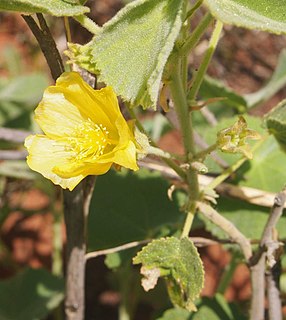
Abutilon otocarpum, the desert lantern, is a small shrub of the family Malvaceae found in most parts of Australia.
















